There are thirteen stanzas to “Thirteen Ways of Looking at a Blackbird.” There are, therefore, thirteen granite blocks with those stanzas etched on them along this walk. There are, however, only ten noted spots along the designated walk. Not only that, there is a confusing stretch along Scarborough Street with no blocks to find. Thanks to the Boston Globe’s excellent article on this Walk for helping me out a bit – both with the blocks and understanding the poem.
Also, This article added a lot of flavor.
…………………………………………………….
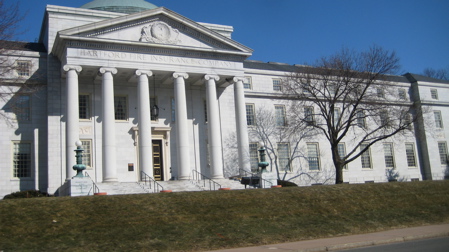
The Hartford Insurance building
I.
Among twenty snowy mountains,
The only moving thing
Was the eye of the blackbird.
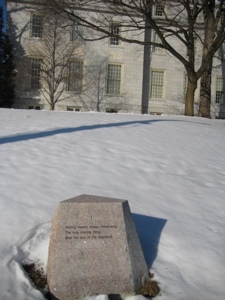 The Walk starts at The Hartford Insurance Group building near downtown where Wallace Stevens worked for 39 years. He never learned to drive to work and walked every day. Along the way, he’d think of poems and jot down bits and pieces. At the Hartford, he was not well liked. He was not a beloved figure, to put it mildly. Everyone has notions of what a poet’s personality is, but whatever emerged in his poetry, that was not his personality here. A future Hartford president once said, “I was one of the few in the company who could stand him and I wanted to knock his block off half the time.”
The Walk starts at The Hartford Insurance Group building near downtown where Wallace Stevens worked for 39 years. He never learned to drive to work and walked every day. Along the way, he’d think of poems and jot down bits and pieces. At the Hartford, he was not well liked. He was not a beloved figure, to put it mildly. Everyone has notions of what a poet’s personality is, but whatever emerged in his poetry, that was not his personality here. A future Hartford president once said, “I was one of the few in the company who could stand him and I wanted to knock his block off half the time.”
He was gruff and hulking and would sometimes answer long technical letters with a letter back stating, “No.” I kind of like this guy. It’s little wonder that the organization that created the Wallace Stevens Walk calls itself the Friends and Enemies of Wallace Stevens.
As for the poem, I don’t know what mountains he’s talking about. They must be metaphorical. John Serio, some guy who is a Wallace Stevens expert says, “This poem is a study in images. A reader should try to imagine each panel with all their might. What kinds of sensations occur? What kinds of feelings or thoughts? Let [the words] appeal to the senses, not the rational mind.”
Hm. That’s going to be hard. Let’s walk west up Asylum.
…………………………………………………….
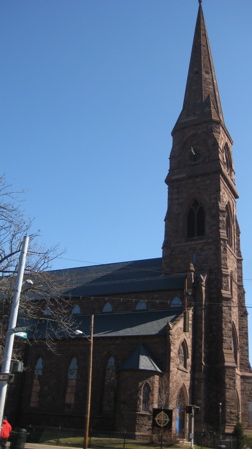
Asylum Hill Congregational Church
II.
I was of three minds,
Like a tree
In which there are three
blackbirds.
This stanza appears behind a black iron fence at Asylum Hill Congregational Church (Mark Twain’s church, by the way) in front of a little tree. Most people think of blackbirds as crows, but there are actually birds called “blackbirds.” Regardless, there are black birds and blackbirds in Hartford.
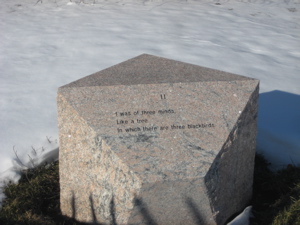 On the way to the church, one can see the Aetna building (CTMQ Visit here) a block to the south. Stevens generally preferred to walk to work alone because he wanted the solitude to compose poetry. But Olcott Smith, 88, former chairman of Aetna, says Stevens sometimes made an exception. “My father, Harry Tyler Smith, lived on Belnap Road and sometimes walked to work with Stevens. Father would pick him up halfway down Asylum Hill. Stevens liked it because my father could whistle. He would whistle Wagner, and he and Stevens would walk, Stevens to the Hartford and my father to the Aetna. But at times – and this is a little embarrassing – a small company bus would come up there and in it would be Morgan and Newton Brainard, and Albert Putnam, and they would say ‘Get in’ to my dad but not to Stevens. I guess they didn’t want him in the bus.
On the way to the church, one can see the Aetna building (CTMQ Visit here) a block to the south. Stevens generally preferred to walk to work alone because he wanted the solitude to compose poetry. But Olcott Smith, 88, former chairman of Aetna, says Stevens sometimes made an exception. “My father, Harry Tyler Smith, lived on Belnap Road and sometimes walked to work with Stevens. Father would pick him up halfway down Asylum Hill. Stevens liked it because my father could whistle. He would whistle Wagner, and he and Stevens would walk, Stevens to the Hartford and my father to the Aetna. But at times – and this is a little embarrassing – a small company bus would come up there and in it would be Morgan and Newton Brainard, and Albert Putnam, and they would say ‘Get in’ to my dad but not to Stevens. I guess they didn’t want him in the bus.
That’s pretty funny.
…………………………………………………….
III
The blackbird whirled in the
autumn winds.
It was a small part of the
pantomime.
The autumn winds were long gone when I did my walk, having given way to the winter snows. The third stanza stands a few hundred feet west beyond the church, in front of the Hartford Conservatory. I’ll defer to the Boston Globe to describe the scene:
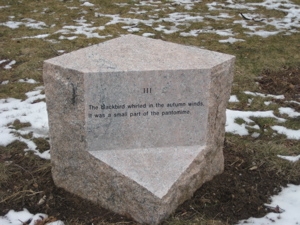 “The streetscape here combines old, residential-scale buildings and steel-and-glass structures of urban-renewal vintage. Sirens create a Dopplering whine. Trees thrust splayed, bony fingers toward the sky, roosts for many blackbirds.”
“The streetscape here combines old, residential-scale buildings and steel-and-glass structures of urban-renewal vintage. Sirens create a Dopplering whine. Trees thrust splayed, bony fingers toward the sky, roosts for many blackbirds.”
And from the excellent Steve Kemper article, this random gem: “In fact, aside from business trips and an annual vacation to Key West, he pretty much stayed home. He carried on no love affairs, caused no scandals, and had no stirring adventures, except for one brief scuffle with Ernest Hemingway, in which Stevens got a black eye and broke his hand on Papa’s jaw. Year in and year out, Stevens went to the office and came home. But there he wrote wonderful poetry. Poetry was his love affair, his adventure, his exotic travel. ”
…………………………………………………….
IV
A man and a woman
Are one.
A man and a woman and a
blackbird
Are one.
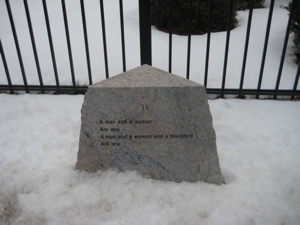 Ah, poetry. So beautiful, so fanciful… so… Huh? I could go poke around to find someone explaining this verse to me, but I choose not to. I think I get it; and I think I’ve felt this way before. So I’ll leave it be.
Ah, poetry. So beautiful, so fanciful… so… Huh? I could go poke around to find someone explaining this verse to me, but I choose not to. I think I get it; and I think I’ve felt this way before. So I’ll leave it be.
This verse has perhaps the worst placement of them all – plopped on a small lawn at a branch of the Hartford Credit Union just before St. Francis Hospital heading west. This stretch of Asylum is particularly busy and often choked with traffic making it difficult to drive. Travel lanes become left-hand turn only lanes or just disappear altogether.
Walking this stretch from the beginning to this point may give some pause, as it does tread fairly near some sketchy blocks, but it’s so busy and and has so many businesses along the way, it’s very safe. In fact, it’s probably easier to walk than drive in a lot of respects. So yes, walk it. Get out there and become one with birds.
…………………………………………………….
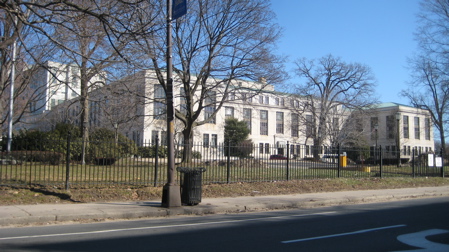
St. Francis Hospital
…………………………………………………….
V
I do not know which to prefer,
The beauty of inflections
Or the beauty of innuendoes,
The blackbird
whistling Or just after.
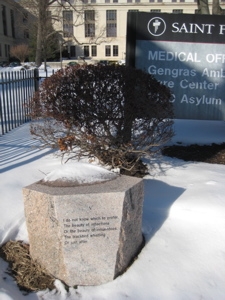 I like this one. It stands close to the road right in front of the huge St. Francis Hospital. The hospital where my son was born, by the way, and this whimsical stanza can be make me think of him if I try hard enough. Damian does not talk, but rather makes sounds and really often nothing more than innuendoes as to what he may possibly want. When we guess right – it’s beautiful. (Guessing wrong usually just results in more gesticulations and more guesses on our part.)
I like this one. It stands close to the road right in front of the huge St. Francis Hospital. The hospital where my son was born, by the way, and this whimsical stanza can be make me think of him if I try hard enough. Damian does not talk, but rather makes sounds and really often nothing more than innuendoes as to what he may possibly want. When we guess right – it’s beautiful. (Guessing wrong usually just results in more gesticulations and more guesses on our part.)
The Boston Globe again describes the area; “Tires of passing cars crackle and splash on the pavement, audible inflections. Across the street, windows in a midcentury building catch murky reflections.” I’m guessing that “mid-century” building is the smallish steel and glass Women’s Center, part of the hospital. This is not a pretty area at all – choked with honking cars and during early March, littered with that charcoal-mud snow concoction found in northeast urban centers.
But we’re about to move westward to a vastly different setting.
…………………………………………………….
VI
Icicles filled the long window
With barbaric glass.
The shadow of the blackbird
Crossed it, to and fro.
The mood
Traced in the shadow
An indecipherable cause.
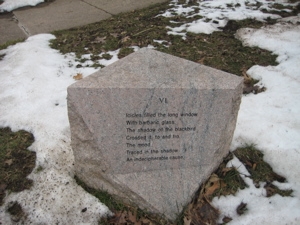 A Stevens expert is quoted in the Globe as saying, “”He constantly changes his perspective, offering many ways of viewing a particular subject. More than anything, he tries to convey the experience of perception, the experience of feeling.” The Globe, then sarcastically notes, “In case that helps.” Ha.
A Stevens expert is quoted in the Globe as saying, “”He constantly changes his perspective, offering many ways of viewing a particular subject. More than anything, he tries to convey the experience of perception, the experience of feeling.” The Globe, then sarcastically notes, “In case that helps.” Ha.
But now, in front of the Greater Hartford Classical Magnet School, all perspective is about to change. Asylum Avenue abruptly changes here from a four lane artery into the city to a two lane twisting drive through some of Hartford’s most historic, artistic and expensive real estate.
Across the street is Hartford’s PBS station, CPTV. This is the worst public station in America, I’m convinced. They certainly trace my mood in shadow. I won’t get into the myriad reasons here, except to say that they never run the shows at the times they submit them to DirecTV so my TiVo rarely catches Nova or Frontline when it should, their entire budget is wasted on UConn women’s basketball games, and they do not offer any sort of haven for locally produced shows. Moving on…
…………………………………………………….
VII
O thin men of Haddam,
Why do you imagine golden birds?
Do you not see how the blackbird
Walks around the feet
Of the women about you?
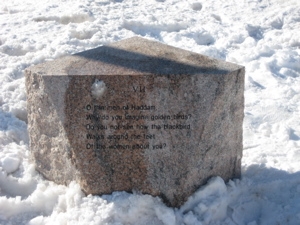 There is a Haddam, CT. And a Middle Haddam, East Haddam, and a Hadlyme for good measure. I have no idea why men from those parts of southern Connecticut only think of golden birds and can’t appreciate the subtle beauty of a black bird. Or why Stevens thinks black birds piddling around women’s feet is enticing.
There is a Haddam, CT. And a Middle Haddam, East Haddam, and a Hadlyme for good measure. I have no idea why men from those parts of southern Connecticut only think of golden birds and can’t appreciate the subtle beauty of a black bird. Or why Stevens thinks black birds piddling around women’s feet is enticing.
Then again, his own grandson Peter Hanchak offers some insight into the genetic psyche of the Stevens line: “”I was only 8 when he died and he wasn’t the kind of grandfather you played ball with or anything. It was Sunday visits, mostly. I can’t recall having any real interaction with him. The few times I was plunked in his lap, I remember playing with the fat little place between his thumb and fingers.” I guess it’s the little things after all.
…………………………………………………….
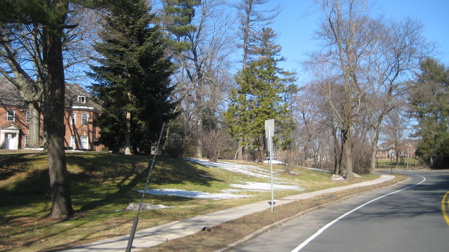
The Asylum Avenue curves
VIII
I know noble accents
And lucid, inescapable rhythms;
But I know, too,
That the blackbird is involved
In what I know.
Why does this verse remind me of David Lynch? The walk’s setting, here, where this block stands however, does not. We’ve left all traces of urbanism and – in the blink of an eye and a single flap of a blackbirds wing – entered an exclusive enclave of expensive cars and massive mansions.
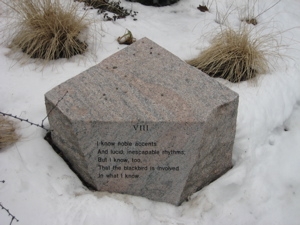 This crossover is abrupt as it is striking. The walk passes the Connecticut Historical Society Museum at the first curve up the slight incline. This fairly large and varied museum has no exhibit honoring Mr. Stevens, despite his twice daily jaunts across the street – and his esteemed place in American poetry lexicon.
This crossover is abrupt as it is striking. The walk passes the Connecticut Historical Society Museum at the first curve up the slight incline. This fairly large and varied museum has no exhibit honoring Mr. Stevens, despite his twice daily jaunts across the street – and his esteemed place in American poetry lexicon.
Asylum Avenue crosses a stream which serves as a boundary between urban and suburban, stark and treed, shabby three-families and impeccable Georgian manses. This delineation has always struck me about Hartford – the same night and day juxtaposition occurs a mile north, along Albany Avenue as well.
Aside from a new McMansion subdivision, these are quite old mansions, formerly housing Hartford’s elite. The new money lives west of here, up on Avon Mountain and points beyond. A “French dry cleaner” van with a delivery man wearing an expensive overcoat and clean shoes pulled into the driveway of the house where the marker stands and dropped off some laundry. I’m sure I could have scored some heroin 15 minutes ago one block off of Asylum and now here I was, avoiding overpriced French delivery men.
…………………………………………………….
IX
When the blackbird flew out of sight,
It marked the edge
Of one of many circles.
Interesting. “The edge.” For I had just passed “The Edge” of the Hartford that makes the newspaper and the Hartford that reads it. Continuing up the hill, past Hartford College for Women and a few massive and beautiful adjunct buildings of the University of Hartford (which is actually in West Hartford), around another curve.
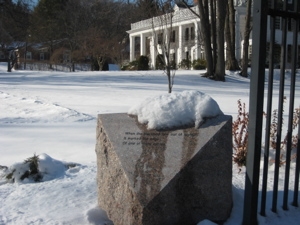 This verse is plunked alongside another driveway of another massive brick mansion with Greek columns and black iron gate. “Keep away from my money and my family” the gate says.
This verse is plunked alongside another driveway of another massive brick mansion with Greek columns and black iron gate. “Keep away from my money and my family” the gate says.
Across the street is the corner of Elizabeth Park, one of Hartford’s jewels. I happen to love this park with its huge lawns, friendly picnic groves, and top-notch rose garden. In opposition to the “keep out” ethic of the elite across Asylum, I’ve been invited to eat with previously unknown black families during their family reunions in the summer – my payment nothing more than a smile and conversation. Maybe this summer I’ll alert them to this Walk.
…………………………………………………….
Diversion
Here, the actual walk of Wallace Stevens and the Walk of the Friends and Enemies of Wallace Stevens diverges. Stevens apparently returned from work each day by walking up Scarborough Street, but the granite blocks do not follow that route. Which is sort of a shame, because Scarborough is a truly unique street, with several quirky and interesting houses along the way.
The actual walk walk alerts walkers to two things:
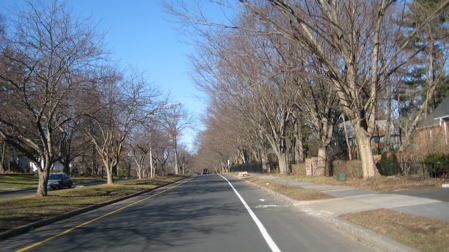
A view down Scarborough Street…
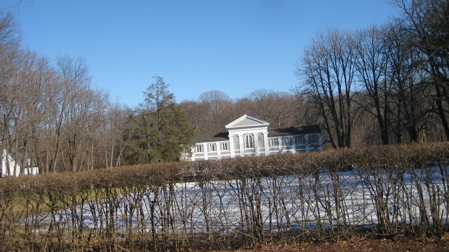
…And the Chick Austin “Hollywood House.”
Chick Austin was one of the few people who were sort of friends with Stevens. Stevens was surely pleased when A. Everett “Chick” Austin turned the Hartford Atheneum (America’s oldest museum!) into the most exciting museum in the country during the 1930s, hosting America’s first exhibition of Surrealism, the first Picasso retrospective, the world premiere of an opera by Gertrude Stein and Virgil Thomson, and visits by many important modern artists. Yet Stevens always declined Austin’s invitations to parties with the guest artists, where he could have exercised his interest in modern art. For such things he always went to New York, where he spent many weekends and where he had several friends in the arts.
The house is appointed with unique examples of eighteenth and twentieth century European furniture and decorative arts. In the 1930s it was a gathering place for leaders of the international art world, including Salvador Dali, Alexander Calder, Gertrude Stein, George Balanchine, Le Corbusier, Cecil Beaton, Martha Graham, Agnes de Mille, Aaron Copland, and Virgil Thomson.
(In 1928 Austin founded The Friends and Enemies of Modern Music, which is where the Friends and Enemies of Wallace Stevens gets its unique name.) It was declared a National Historic Landmark in 1994. (CTMQ’s visit here.)
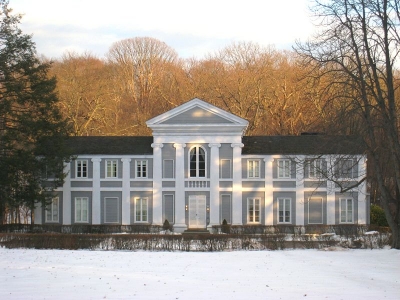
The house, only one room deep, is long and narrow, 86 feet in length by 18 feet in depth. In the front elevation, the central three-bay pedimented pavilion is flanked by four-bay wings. The bays are defined by shallow, two-story Ionic pilasters. The walls of the pavilion and wings are in the same plane, since the pavilion does not project. The planar effect is emphasized by the wall sheathing, which is flush boarding, tongue-in-groove. The twelve flat pilasters rise with entasis from bases of double torus moldings to stylized Ionic capitals. Two string courses, one at first-floor ceiling height, the other below second-floor window sills, establish a horizontal orientation to balance the strong upward thrust of the pilasters.
It is locally known as the “Hollywood House” because it looks like a facade of a house, rather than a house. Many people think that is all it is – especially since no one lives there as it’s been donated to the Wadsworth and you can check it out on a Thursday for 25 bucks. “>can be visited if you donate $25 to some fund at the museum.
…………………………………………………….
Back to the Walk with the poem guiding me… A turn off of Asylum into a moneyed neighborhood.
X
At the sight of blackbirds
Flying in a green light,
Even the bawds of euphony
Would cry out sharply.
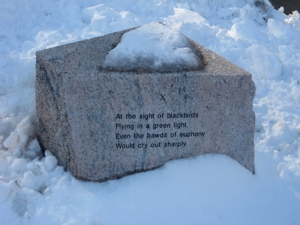
Oh those bawds of euphony. This verse is plopped on a slope in front of yet another rather large house, across from Elizabeth Park, a favorite Stevens haunt. “He loved the manicured nature you find in a city park, but of course he was fascinated by the destruction and decay there, too,” someone told the Boston Globe.
…………………………………………………….
Turning right down Terry Road, a rather nice address to have, and away from the clatter of Asylum Avenue towards the clatter of young, well-off families instead. The next block is propped up on an incline at the corner of Westerly Terrace – Stevens’ street!
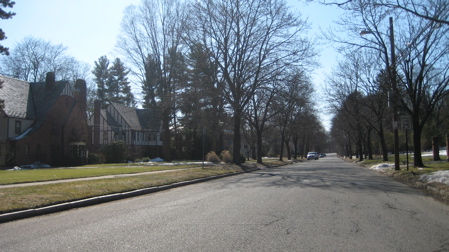
Heading down Terry Road
XI
He rode over
Connecticut In a glass coach.
Once, a fear pierced him,
In that he mistook
The shadow of his equipage
For blackbirds.
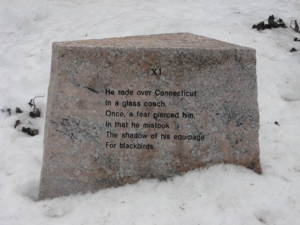 Now on Stevens’ steet, an odd one-way two-laned road split by a large median, connecting out to Albany Avenue, one notices the birds more than the cars and busses. A few neighbors knew who the hulking walker was, but most just tolerated his gruffness.
Now on Stevens’ steet, an odd one-way two-laned road split by a large median, connecting out to Albany Avenue, one notices the birds more than the cars and busses. A few neighbors knew who the hulking walker was, but most just tolerated his gruffness.
One neighbor, Arthur Polley, thought Stevens was an eccentric. One day, Polley was driving by a bus stop and saw Stevens there. Polley stopped and asked Stevens if he would like a ride. Stevens paused for a moment and then said that he would accept if Polley did not speak during the ride. They rode the entire trip in silence.
…………………………………………………….
XII
The river is moving.
The blackbird must be flying.
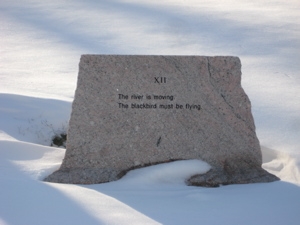 Now on Westerly Terrace and approaching “home.” Stevens lived a solitary life to be sure, and it appears did not cultivate any close friendships. Yet, his poetry was important enough to inspire this little walk in Hartford.
Now on Westerly Terrace and approaching “home.” Stevens lived a solitary life to be sure, and it appears did not cultivate any close friendships. Yet, his poetry was important enough to inspire this little walk in Hartford.
I passed a mother and her toddler, attempting to ride a tricycle on the sidewalk. There were indeed birds flitting about – robins mostly, but some bluejays as well. It’s hard to say how much the landscape and scenery along this walk has changed in the years since Stevens walked it, but probably not all that much.
However, go back 100 years and I’m sure it has changed immensely. But Elizabeth Park is still here. And the massive oaks near the Historical Society. And the stream by the magnet school.
And the birds still come back. Every year.
…………………………………………………….
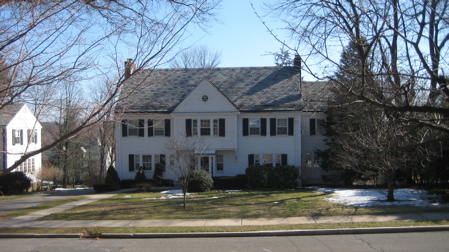
Wallace Stevens’ house
XIII
It was evening all afternoon.
It was snowing
And it was going to snow.
The blackbird sat
In the cedar-limbs.
We are done. In the grass in the median in front of 118 Westerly Terrace stands this final verse. Stevens’ home is perhaps the most modest I’ve seen in the last mile of this trek, but that’s how he wanted it I’m sure.
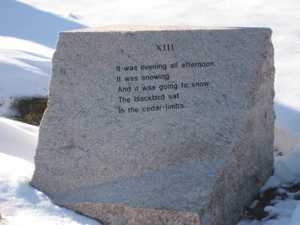 I’ll let Steve Kemper have the final paragraphs: “Stevens’ final Hartford residence is Cedar Hill Cemetery (CTMQ Visit here). I visited on a drizzly morning dense with fog. Though I knew his address – section 14, lot 64 – I couldn’t find him, and drove around and around, shadowed by raucous crows that swooped in and out of the fog. It seemed like a metaphor as well as another of Stevens’ evasions. I finally found the right section, off by itself, out of order, in the opposite direction that logic would suggest. It figured.
I’ll let Steve Kemper have the final paragraphs: “Stevens’ final Hartford residence is Cedar Hill Cemetery (CTMQ Visit here). I visited on a drizzly morning dense with fog. Though I knew his address – section 14, lot 64 – I couldn’t find him, and drove around and around, shadowed by raucous crows that swooped in and out of the fog. It seemed like a metaphor as well as another of Stevens’ evasions. I finally found the right section, off by itself, out of order, in the opposite direction that logic would suggest. It figured.
Even then I couldn’t find him. After tramping through the slush and drizzle for 20 minutes I finally conceded victory to Stevens and turned back toward the car. That’s when I saw his marker, obliquely, out of the corner of my eye. I had passed it half a dozen times. Nothing on the modest brown-granite stone hinted that the man buried there was an acclaimed poet. As taciturn in death as in life. The drizzle suddenly turned into rain, making my notes run and sopping the paper so that finally my pen wouldn’t write at all. I chuckled and ascribed it to Stevens, still carrying privacy to absurd lengths. He would hate this article.”
And he’d hate mine a lot more.

Wallace Stevens
…………………………………………………….
The poem, unencumbered
Wesleyan Walking Tour Guide
Friends and Enemies of Wallace Stevens
Boston Globe article
Steve Kemper article
The Enigma of Wallace Stevens – excellent Hog River Journal article
The Hartford – hurry before it collapses
Asylum Hill Congregational Church
The Hartford Conservatory
Connecticut Historical Society

 doug says
doug says
April 10, 2009 at 6:35 pmYou wondered why Stevens singled out Haddam in his poem. According to the notes in the Norton Anthology of English Poetry, Stevens said that “The thin men of Haddam are entirely fictious.I just like the name…In any case, it has a completely Yankee sound.
 Beth Critton says
Beth Critton says
July 14, 2009 at 7:57 amI am thinking of doing this walk on September 12 for the Appalachian Mountain Club’s CT Chapter New Members Day.
I would guess that I will have about 8 people. Where do you suggest that we park at either end?
Thank you.
Beth
 Jim Finnegan says
Jim Finnegan says
October 15, 2009 at 11:40 amThis is a great piece. We just completed a new website:
http://www.stevenspoetry.org
I’ll link to this post.
Also, can a I use a few of your photos for our site? We’re missing photos of some of the stones.
 Dimitri says
Dimitri says
November 3, 2010 at 11:37 pmI could not agree more about the Haddam part. What is he talking about? Good article with plenty of humor!
PS: I also don’t know why the men from Haddam think like this. Most people probably don’t know either.
 Henry S says
Henry S says
May 26, 2025 at 12:19 amThere are no thin men in Haddam. I joke…. I’ve seen some of the stone markers before, and didn’t know what they were for. It’s a pretty cool trail idea and wispy, fitting for poetry. It’s even neat that it’s on the periphery of the city. The pictures of the markers in the snow captures them uniquely. I haven’t heard the name of Wallace Stevens in a super long time, previous to moving to CT.